Join us for conversations that inspire, recognize, and encourage innovation and best practices in the education profession.
Available on Apple Podcasts, Spotify, Google Podcasts, and more.
Look for the following topics in the video, indicated by the ![]() onscreen icon, and click below to learn more.
onscreen icon, and click below to learn more.
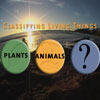 Classifying Living Things |
 CO2 and O2 |
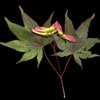 Taxonomic Classification |
 Teaching Tips |
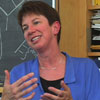 Scientist at Work |
Curriculum Resources |
The classification of life on Earth is an ongoing and dynamic endeavor. Early classification schemes identified the kingdom as the broadest grouping and employed a two-kingdom categorization strategy: Plants and Animals. However, a five-kingdom strategy has been dominant for many decades: Plants, Animals, Fungi, Protists, and Bacteria. With advances in the ability to discern fundamental differences in cell structure and function as well as evolutionary relationships, the domain is now considered the broadest grouping. The most fundamental difference is the presence of a nucleus. The organisms in the domains Archaea and Bacteria are prokaryotic (“before the nucleus”) while the organisms within the domain Eukarya are eukaryotic (“after the nucleus” or “true nucleus”).
In the video, a strategy for classification based on cell features was introduced to group life forms into domains and, within the domain Eukarya, into kingdoms. Classification into kingdoms in the Archaea and Bacteria domains continues to occupy microbiologists as techniques improve. And, within the Protist kingdom, it is very likely that several different kingdoms will eventually be defined, as this group does not accurately reflect evolutionary relationships.
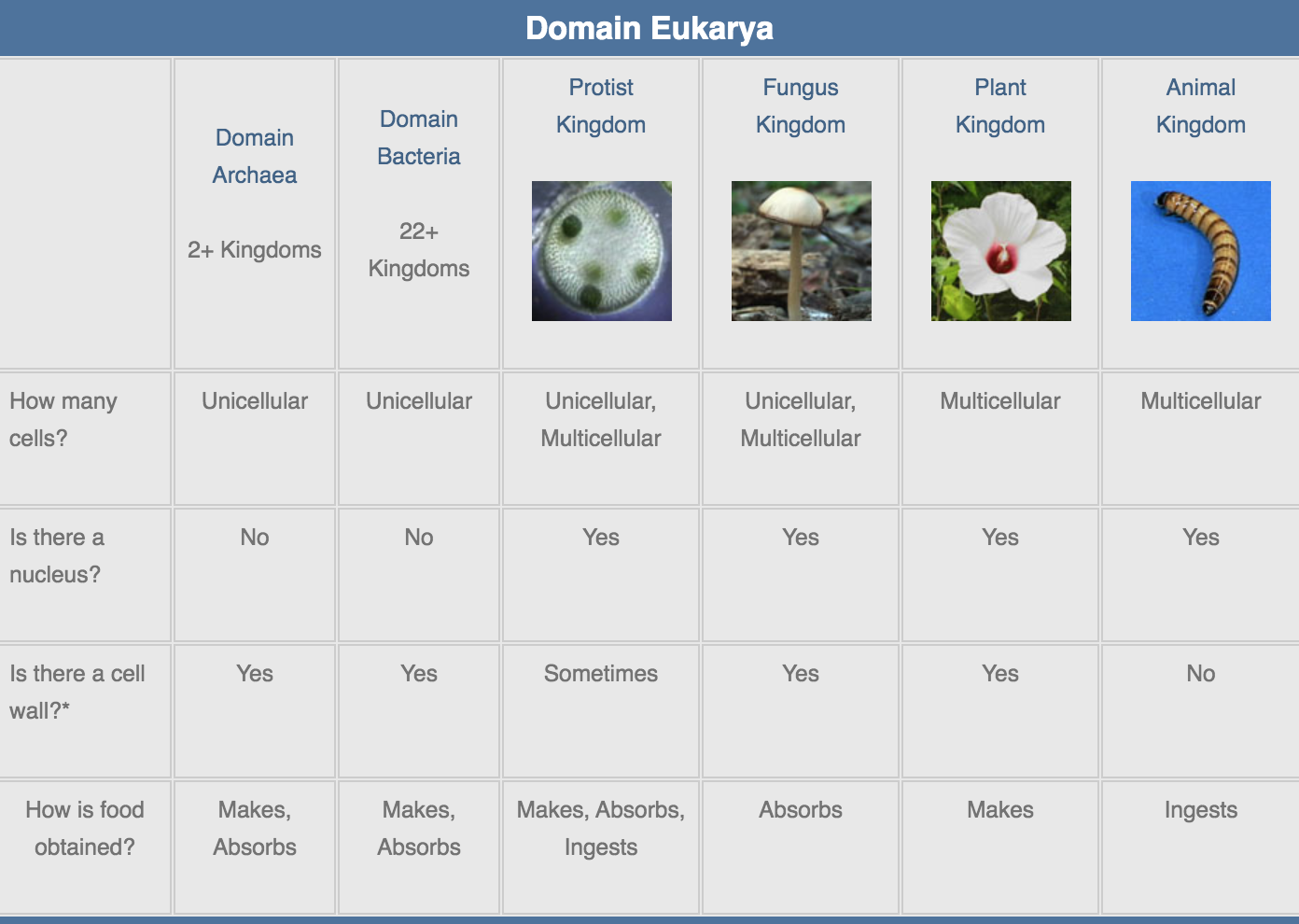
*The cell walls in these different groups are not made of the same materials and, thus, the presence of a cell wall only reflects similarity within a group, not between groups.
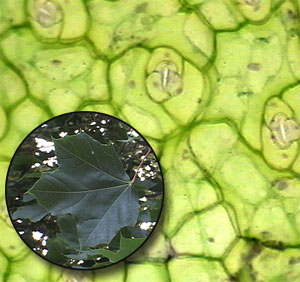
Leaf (inset) and leaf cells.
Plants are eukaryotic organisms, meaning their cells contain nuclei as well as organelles. They are multicellular and have the ability to make their own food. Plant cells are different from animal cells because they have a cell wall. The cell wall, made of a compound called cellulose, gives structural support to plants, allowing them to stand tall. Plant cells are also unique from animal cells in that they contain an organelle called chloroplast, where they use the energy from sunlight to convert carbon dioxide and water into food during the process of photosynthesis. A chemical in chloroplasts that is involved in photosynthesis — chlorophyll — is what gives plants their green color.
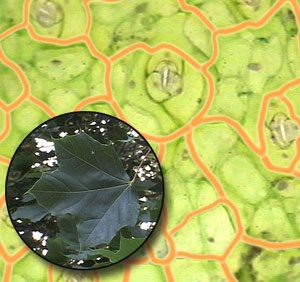
Leaf (inset) and leaf cells.
As well as being important food sources, plants are well known as a source of many important chemicals that are used in medicine, cosmetics, and agriculture. Because land plants are unable to move, they have evolved multiple adaptations to facilitate their success and ability to thrive in a range of ecosystems. For instance, many plants produce pesticides to protect themselves from insects. These pesticides have practical uses for humans. In fact, caffeine is technically a pesticide! Other chemicals may be toxins to dissuade larger animals from eating the plant leaves or fruits. Conversely, some chemicals are actually produced to attract animals — the scents of flowers are good examples. Other ways of attracting animals include special colors and shapes of flower and leaf parts as well as nectar production. The purpose of these enticements is to encourage animals to stop by and eat, ultimately leading to pollination of the flowers and increasing reproductive output.
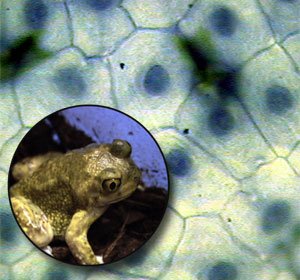
Frog (inset) and frog cells.
Like plants, animals are eukaryotic organisms. They are multicellular with cells that contain nuclei and many different organelles that carry out various cell functions. Unlike plants, animals cannot produce their own food. They obtain food by ingestion — they take it in whole or in small chunks. Animals may eat plants, or other animals. Some animals, such as humans and bears, have a mixed diet of plant and animal food sources.
Animal cells also lack cell walls. Their cells are simply enclosed by a cell membrane. Thus, they lack the structural rigidity seen in plant cells. However, animals have a startling diversity of shapes and sizes that are supported by different types of skeletons.
The immense diversity of animals and their importance on this planet is truly remarkable. Of course, animals are a food source. But animals play many roles in their environments. Animals with a backbone, known as vertebrates, represent those species best known by children. The majestic creatures of the African bush and the brightly colored fish of a coral reef are well-recognized examples of vertebrates. However, the diversity of invertebrates, which are animals that lack a backbone and are typically structurally less complex, is equally, if not more, amazing. From the insects of the terrestrial world to the untold wealth of life in the sea, millions of species exist that possess bizarre and novel adaptations for success in their respective environments. These adaptations are based on avoiding predators, attracting prey, and mating.
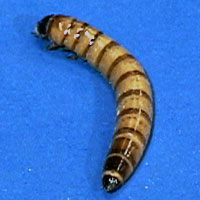
Invertebrate (earthworm)
Lacks a backbone
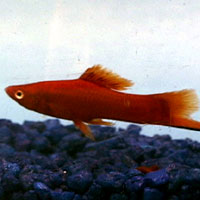
Vertebrate (fish)
Has a backbone
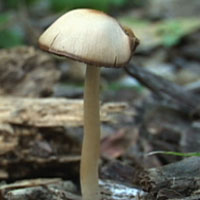
Mushroom
Fungi are multicellular eukaryotes. Like plants, their cells are enclosed by a cell wall, although fungal cell walls are composed of a different compound from plant cells, called chitin. This compound is very similar to the compound found in the hard skeletons of insects. Like animals, fungi are unable to make food and thus require an external food source. However, instead of ingesting food, fungi take in food through absorption. From tiny root-like hairs that penetrate the surface of the food, digestive chemicals are secreted onto food sources outside of the organism. The food is broken down into nutrient molecules and is absorbed into fungal cells.
Fungi are very important as decomposers in a range of terrestrial ecosystems. By breaking down dead organisms, fungi serve to keep important elements, such as nitrogen, cycling in the environment. Like plants, fungi are also the source of significant biochemicals. One of the most important discoveries in medicine is the antibiotic penicillin, which was actually taken from common bread mold!
The most diverse group of organisms in this classification system is found among the Protists. This group contains plant-like, animal-like, and fungus-like organisms. This grouping is not based on evolutionary relationships but is more a grouping of convenience — the protists are the eukaryotes that aren’t plants, animals, or fungi. This may seem to violate the precision that seems important in a classification system, but this is what has been used historically and is commonly taught in K-6 classrooms and beyond. There will likely be changes in this grouping as the science of classification progresses.
The majority of organisms classified as protists are unicellular though there are a few multicellular organisms. For example, kelp (“seaweed”) is technically a protist even though it is multicellular. Kelp is not grouped with plants, however, because it lacks the cellular complexity present in plant cells. There are also “colonial protists,” which are aggregates of individual cells of the same species that function together as a group.
Plant-like protists make their own food, and many have cell walls made of cellulose. Animal-like protists cannot make their own food and ingest it. Some animal-like protests have “shells,” called tests, which are made of silica or calcium carbonate. Other animal-like protists lack a cell wall or protective test. The fungi-like protists are actually not evolutionarily related to fungi, although they do take in food by absorption. Like plants, however, their cell walls are made of cellulose.
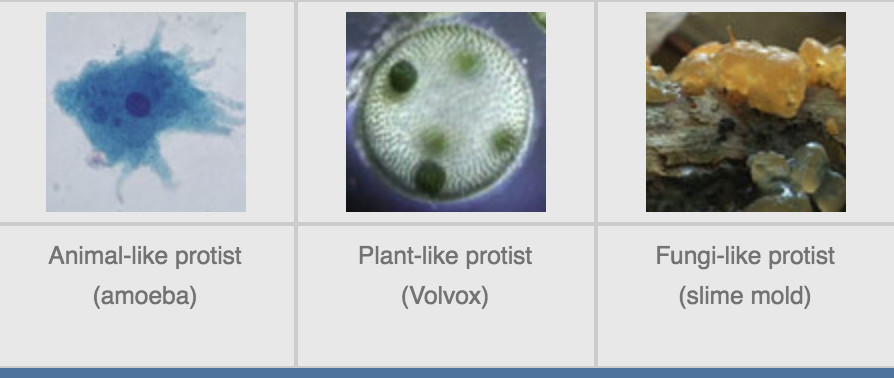
Animal-like protists include some well-known species. Paramecia and amoeba are frequently used examples of single-celled organisms. Malaria, a world-wide disease occurring in tropical climates, is caused by an animal-like protist, the Plasmodium. In the ocean, many plant-like protists live at the surface where they perform photosynthesis. These organisms, such as diatoms, dinoflagellates, and foraminiferans, serve as a food source to many planktonic, or floating, animals. However, these plant-like protists are not always beneficial. Red tide is caused by a population explosion in poisonous dinoflagellates and contaminates the ecosystem, killing fish and making shellfish unsafe for human consumption. The fungus-like protists are commonly known as slime molds, and include the brightly colored organisms found growing on decomposing trees and the pesky mildew growing in a bathroom.
Representing potentially the largest group of organisms on this planet, the domain Bacteria is composed of a remarkably diverse group. From deadly diseases to “helper” bacteria in our bodies, bacteria inhabit almost every ecological niche known. Colonizing spaces in other organisms, in the deep-sea, and even in toxic waste sites, bacteria are single-celled organisms known for their striking diversity.
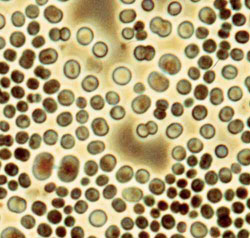
Cyanobacteria, image courtesy of Cyanosite
Even though these prokaryotic organisms lack a nucleus and organelles, they are able to exploit a wide range of substances for food sources. Bacteria do have a cell wall, which includes the compound peptidoglycan, also found in fungal cell walls. There are two common shapes among bacterial cells: rods and spheres.
Unlike animals, bacteria do not ingest their food. Many bacteria are like fungi in that they secrete digestive chemicals into the local environment to break down complex molecules, which they then absorb. Some bacteria are like plants and are able to make their own food through photosynthesis. In fact, most of the photosynthesis on Earth occurs in the open ocean and is carried out by a group of bacteria called cyanobacteria, or blue-green algae. However, many bacteria use reactions completely different from plants to make their own food from an array of chemicals. And, there are bacteria that are able to switch between making their own food and absorbing food from an external source.
Bacteria are important to humans in many ways. Did you know that bacterial cells outnumber human cells in our bodies? Many times they are portrayed as germs and agents of disease but there are also many beneficial and practical applications of bacteria in our everyday lives. Some bacteria serve to ward off infection in our bodies as well as to facilitate digestion. Wine, cheese, and yogurt are produced with bacterial cultures. Furthermore, certain bacteria produce important compounds used in industrial and pharmaceutical industries.
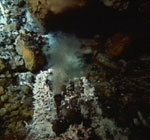
Thermal vents, home of
some Archaea
The domain Archaea contains many organisms that are not very well characterized. Archaeans are prokaryotic, single-celled organisms. Their cells have a cell wall, but it is not made of the same substances found in the cell walls of plants, fungi, and bacteria. Despite lacking the organelles and nuclei seen in eukaryotic cells, the archaea are actually not that similar to bacteria. In fact, based on their DNA and various fundamental cell processes, they are more closely related to eukaryotic organisms.
Most archaea do not make their own food. Many absorb their food sources, in a similar way to bacteria. Archaeans that do make their own food do not make it through photosynthesis — that is, using carbon dioxide, water, and the sun’s energy. They may use other sources of carbon found in the environment, and chemicals for energy rather than light.
Archaea were initially discovered in extreme, inhospitable environments like hot springs and deep-sea hydrothermal vents. We now know they occur in a diversity of environments, including cow guts, where they produce methane, and many aquatic ecosystems. Techniques in molecular biology are revealing a striking diversity of archaea in many habitats. Unlocking the mystery of what they are and how they are transforming their environment is proving to be a very exciting challenge for microbiologists.
Life on this planet is characterized by the need to acquire carbon to make the organic molecules that compose and are used by an organism’s cells. Some organisms, like plants, some protists, and many bacteria, are able to extract carbon dioxide gas (CO2) from the environment and convert it into organic carbon. In photosynthesis, for example, the carbon in CO2 becomes part of a sugar molecule, which becomes a source of energy as well as building materials. The gas CO2 is thus a key molecule in organisms that make their own food.

Oxygen burning in a flame
Another critical gas is oxygen gas (O2). Much of life on this planet is aerobic, meaning oxygen is required for survival. Oxygen serves as a key constituent in the process that releases the energy stored in food. The oxygen is used in cell respiration, which is a process that is much like burning a candle. When a candle is burned, O2 combines with the chemicals that store energy in wax, producing light and heat energy. When food is burned, O2 combines with sugar, making its energy available to fuel cell processes.
Something that surprises many people is that plants and other photosynthesizes require O2 as well as CO2. Photosynthesis is indeed the process by which plants make food, but once this food is made, cellular respiration is required to release its energy. Plants thus require both gases for survival.
Many organisms, even humans, are capable of anaerobic energy production in a process known as fermentation. Fermentation processes do not produce as much energy as aerobic reactions and often generate harmful byproducts. An example in humans is the production of lactic acid by lactic acid fermentation in muscle cells during exercise. This occurs when O2 supplies in muscles are insufficient and the body adjusts by using fermentation as an energy reaction. This leads to the familiar burning sensation in overworked muscles. Fermentation is the process that creates many food products: yogurt, wine, and cheese, for example. In addition, there are certain bacteria, archaea, and protists that are strictly anaerobic, meaning oxygen is poisonous. Their only energy reaction is fermentation. These organisms live in habitats such as sediments or lakes that totally lack oxygen.
A hierarchical system is used for classifying organisms to the species level. This system is called taxonomic classification. The broadest classifications are by domain and kingdom; the most specific classification is by genus and species. The hierarchical groupings in between include phylum, class, family, and order.
Species are the basic unit of classification. While there are different views on what defines a species, in sexually reproducing organisms, a species has traditionally been defined by the ability of its members to reproduce together to form fertile offspring. This definition is trickier in asexually reproducing organisms like bacteria, archaea, and protists, where scientists look at the similarity in DNA among individuals to tell whether they are in the same “species.”
When identifying an organism, familiar names — like human, fruit fly, or maple tree — are most likely the names you use. However, each type of organism has a scientific name — humans are called Homo sapiens, for example. Scientific names are derived from the genus and species names in a system known as binomial nomenclature (“bi” = two; “nom” = name). When species names appear in print, the genus is always capitalized and the species name is not, and both names appear in italics (or underlined).
This system allows for a common language with which biologists can both classify and compare organisms. It also provides a basis for biologists to communicate their findings with other scientists. A key aspect of taxonomy is the ability to characterize each level of description with unifying features, thus relaying information about the organism(s).
For example, for Homo sapiens, the classification would break down as follows:
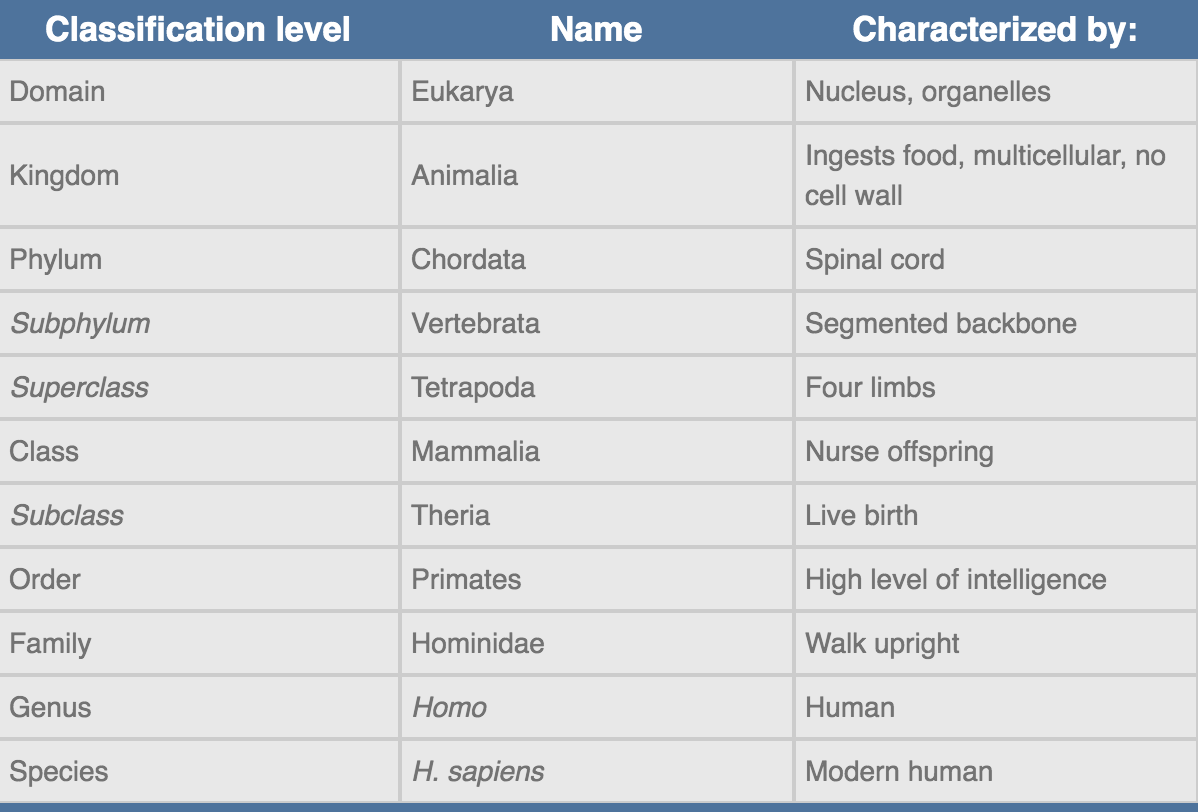
Below is an additional example of the classification of an animal. This is for an invertebrate, the fruit fly, which is used by many biologists to study genes and heredity.
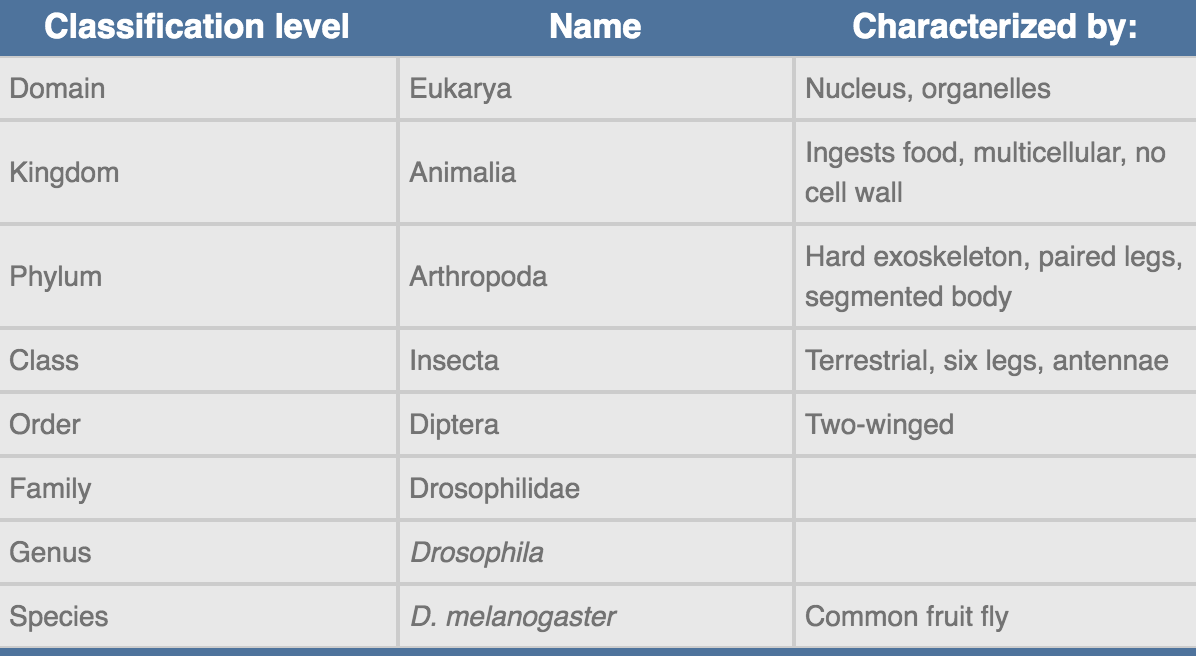
Furthermore, similar schemes are used for plants. Below is the description used to characterize a tree, the red maple.
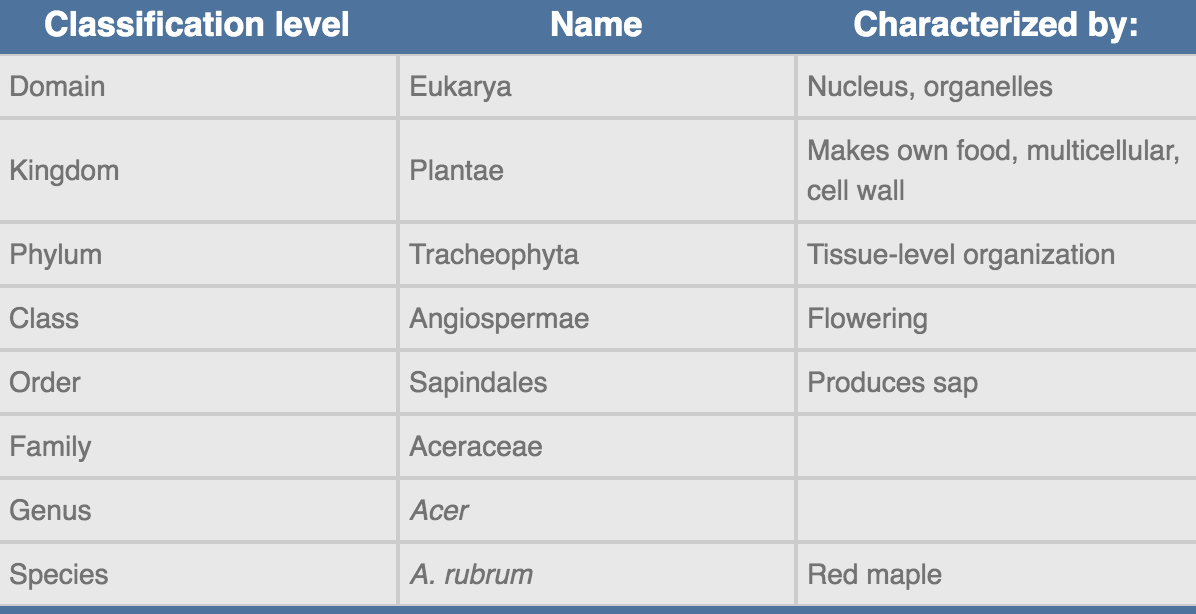
As additional organisms are described and additional features are found which differentiate these groups, biologists have added taxonomic levels to distinguish groups from one another. As seen in the Homo sapiens table, there are “sub” and “super” groupings which come before or after the traditional taxonomic level. This further level of detail gives scientists more power to describe organisms.
Not surprisingly, there are levels “below” species. Particularly common in bacteria and plants, “subspecies” are described which can produce viable offspring but possess one or more features which distinguish them from other members of that species. In plants, these sub groups are referred to as different “varieties” or “subspecies,” while in single-celled organisms, they are referred to as “strains.” Within the animal kingdom, subspecies may be termed “races” or “breeds.” For example, all domesticated dogs are grouped in the same species, Canis familiaris, though we all know there is a huge diversity of subspecies, or breeds.
Ideally, the taxonomic classification reflects evolutionary relationships among organisms. For example, it is accepted that all organisms included in the phylum Chordata descend from a common ancestor. Currently, many biologists are using DNA sequence data to verify taxonomic descriptions of organisms and determine the patterns of evolution within and between different groups.
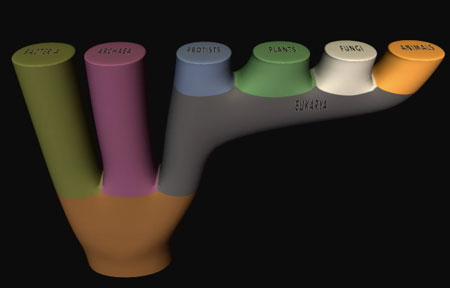 One of the best things about Life Science is how easy it is to bring the living world into the classroom. If your students are exploring the diversity of life on Earth through classification, you’ll have no difficulty providing an array of plants and animals for firsthand study. Terrariums and aquariums—such as those seen in the video in Stephanie Selznick’s first-grade classroom—are excellent small-scale study systems. The TerrAqua Column, which is described in Bottle Biology on this Web site, provides a similar opportunity.
One of the best things about Life Science is how easy it is to bring the living world into the classroom. If your students are exploring the diversity of life on Earth through classification, you’ll have no difficulty providing an array of plants and animals for firsthand study. Terrariums and aquariums—such as those seen in the video in Stephanie Selznick’s first-grade classroom—are excellent small-scale study systems. The TerrAqua Column, which is described in Bottle Biology on this Web site, provides a similar opportunity.
As your students understandings of plants and animals grows, you may wish to introduce other groups of living things featured in the video—the fungi, protists, bacteria, and archaea. Some suggestions for bringing these life forms into your classroom are provided below.
Your students are likely to be familiar with typical examples of fungi—the mushrooms— and many will consider them to be plants. One way to help students distinguish between these two groups is to bring examples in and compare them side by side. The supermarket is a great source of these familiar fungi with most carrying a variety of types.
You might also start a field collection of fungi. During warmer and wetter months, a walk through the woods or a park can provide an astounding variety of specimens. Decaying plants and dead trees are great sources of fungi in the “wild”. Of course, no field specimen should ever be tasted!
Molds and yeasts are also examples of microscopic fungi that can be brought into the classroom. One way to collect molds is to use unpreserved bread to swipe different surfaces. The bread can be put into a plastic baggie and left for observation over time, with slightly moist bread being more likely to yield results more rapidly.
A more sophisticated way to culture both molds and yeasts is to purchase Petri plates with prepared media from a biological supply company. A type that contains “Sabouraud Dextrose Agar” selects for fungi, although “Trypticase Soy Agar” or “Nutrient Agar” will also work. These plates, which are sterilized when they are prepared, provide a food source for molds and yeasts. All you have to do is rub a cotton-tipped swab (which can also be purchased sterile if you wish) on a surface of interest and then apply it as a “streak” onto the plate, which is then incubated upside-down. The molds generally appear “fuzzy”, while the yeast colonies appear as “dots”.
There are few precautions in culturing fungi in this way—they grow in a closed container and are types that are already present in the environment. To dispose of the plates, spray with disinfectant solution, seal, and throw away. The only thing to be careful about is opening the plate—every time you do, you can introduce new microbes!
An example of culturing fungi in this manner can be seen in a Bottle Biology activity using the EcoColumn called “Basically, I’m a Fungi”.
The first time a student looks under a microscope at a drop of pond water is likely to hook them on the world of protists. This is what enthralled Anton Van Leuwenhoek, the inventor of the first microscope. There are few special “tricks” to observing these creatures—a compound light microscope, glass slides (depression slides are best), cover slips, and droppers are the basic supplies. You can also purchase solutions to slow them down, such as “ProtoSlo” or… if you don’t have a microscope, borrowing one from a middle or high school and sharing views of your samples with colleagues and administrators may even be a way of making a case for purchasing one. It’s even possible to distinguish between the plant-like forms, which are characteristically green, and the animal-like forms, which move in various ways.
Perhaps the most ubiquitous organisms on Earth are the bacteria. Your students are likely to be familiar with the word, and it is easy to bring meaning to it by culturing bacteria in your classroom—they’re on every surface. Like molds and yeasts, bacteria can be cultured on Petri plates with prepared media. “Trypticase Soy Agar” or “Nutrient Agar” will yield excellent results. Bacteria are cultured in the same way as fungi, by swabbing a surface of interest, applying it in a streak to the surface of the plate, and incubating it upside-down. Bacterial colonies will appear as tiny “dots” on the surface of the medium—each dot represents the offspring of one bacterium. To dispose of the plates, spray with disinfectant solution, seal with tape, and throw away.
An example of culturing bacteria in this manner can be seen in a Bottle Biology activity using the TerrAqua Column called “What is It?”
One reason that the archaea are fascinating is that they characteristically grow in extreme environments. For this reason, they are not good candidates for bringing into the classroom as live cultures—even microbiologists are challenged with getting them to grow out of their natural habitats. If you’re interested in introducing your students to this group, this Web site may be useful: http://www.ucmp.berkeley.edu/archaea/archaea.html.
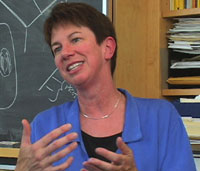 Dr. Colleen M. Cavanaugh is the Edward C. Jeffrey Professor of Biology in the Department of Organismic and Evolutionary Biology at Harvard University. She received her M.A. and Ph.D. degrees from Harvard University, in 1981 and 1985, respectively. Professor Cavanaugh’s continuing research interests include prokaryote-eukaryote symbiosis, including its physiology, biochemistry, ecology, evolution, and the co-evolution of host and symbiont; the physiology, molecular biology, ecology, and evolution of autotrophs and methanotrophs; as well as microbial cycling of inorganic and organic compounds. In addition to her teaching responsibilities at Harvard, Dr. Cavanaugh is a Visiting Investigator at the Woods Hole Oceanographic Institution. She has ten deep-sea research cruises worldwide and twelve deep-sea dives on the submersible Alvin to her credit. She is the author or co-author of approximately 50 peer-reviewed scientific papers.
Dr. Colleen M. Cavanaugh is the Edward C. Jeffrey Professor of Biology in the Department of Organismic and Evolutionary Biology at Harvard University. She received her M.A. and Ph.D. degrees from Harvard University, in 1981 and 1985, respectively. Professor Cavanaugh’s continuing research interests include prokaryote-eukaryote symbiosis, including its physiology, biochemistry, ecology, evolution, and the co-evolution of host and symbiont; the physiology, molecular biology, ecology, and evolution of autotrophs and methanotrophs; as well as microbial cycling of inorganic and organic compounds. In addition to her teaching responsibilities at Harvard, Dr. Cavanaugh is a Visiting Investigator at the Woods Hole Oceanographic Institution. She has ten deep-sea research cruises worldwide and twelve deep-sea dives on the submersible Alvin to her credit. She is the author or co-author of approximately 50 peer-reviewed scientific papers.
Science and Technology for Children™ is an innovative, hands-on science program for children in grades one through six developed by the National Science Resources Center (NSRC). The 24 units of the STC program are designed to provide students with stimulating experiences in the life, Earth, and physical sciences and technology while simultaneously developing their critical-thinking and problem-solving skills.
The STC units provide children with the opportunity to learn age-appropriate concepts and skills and to acquire scientific attitudes and habits of mind. In the primary grades, children begin their study of science by observing, measuring, and identifying properties. Then they move on through a progression of experiences that culminate in grade six with the design of controlled experiments. For more information, contact:
Carolina Biological Supply Company
1-800-334-5551
http://www.carolina.com/